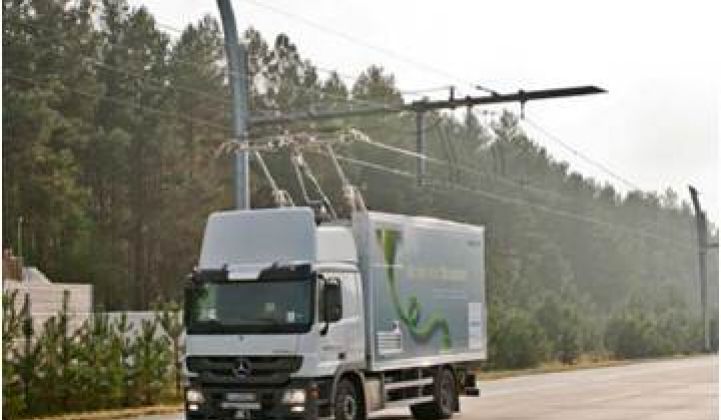Plans are being made to do a proof-of-concept test on Siemens’ eHighway of the Future along one of the filthiest sections of freeway in the Los Angeles basin.
Siemens is working out details for its eHighway of the Future concept with California’s South Coast Air Quality Management District (SCAQMD) on the floor of the Los Angeles Convention Center at the 26th Annual Electric Vehicle Symposium while 200 vendors hawk the hardware and software of the electric transport transition all around them.
The proposal is to build overhead electrified wires along the section of freeway that leads into the ports of Los Angeles and Long Beach, where trucks daily line up bumper-to-bumper for miles, waiting to load and unload, all the while spewing diesel fumes into the LA air.
Trapped by an inversion layer of hot desert air hovering over cooler coastal air, the brown-gray spew that comes along with the ports’ world-class import-export traffic plays a major part in creating LA’s world-famous hazy horizon.
The eHighway of the Future would automatically enable a connection between any truck with electric drive capability and overhead catenary wires, allowing the vehicle to idle without emissions or noise.
The cost of building the four-mile-long proof-of-concept project, according to an SCAQMD report done in anticipation of the pilot project with Siemens and released in conjunction with the announcement of Siemens’ eHighway concept, is estimated at up to $5 million to $6 million per mile, or as high as $24 million.
In contrast, a fixed-rail electric system that would comparably reduce emissions, according to the SCAQMD study, would cost some nineteen times more.
Once the eHighway of the Future concept proves itself in Los Angeles, said Siemens spokesperson Michael Krampe, the company will approach a long list of other cities in the U.S. and Europe with similar trucking and air-quality concerns.
Freight transport is expected to be broadly responsible for nearly a third of the world’s carbon dioxide emissions by 2030. Highway freight transport in the U.S. is expected to double by mid-century.
The catenary wires Siemens would build are very similar to those used by current-day trolleys and streetcars. Any truck with an electric drive capability could have a sensor at the front and a pantograph and control system on top. The sensor would automatically detect the wired section of freeway as the truck approached and, within seconds, activate the control system. The pantograph would rise, contact the wires and initiate supply of power to the truck’s electric drive.

Siemens has developed proprietary technology -- the wires and superstructure and the software and hardware for the truck -- for its test project in Germany. That technology would be built out for the SCAQMD proof-of-concept project in Los Angeles.
Freight carriers running on Siemens’ proprietary ELFA hybrid diesel-electric drive system, or any other hybrid drive system (standard gasoline, compressed natural gas or fuel cell), or any pure battery power, could connect to the eHighway. The technology, Krampe said, is “OEM-agnostic.”
The SCAQMD study found that, driven by federal and state emissions regulations, the market for such a system could be in use by 46,000 trucks in the South Coast Air Basin by 2030. It detailed an extensive set of financial and other costs and benefits for the transition to battery drive technologies.
Ultimately, emissions regulations are likely to be as much a part of the decision by truck owners to make that transition as market factors. The reduced costs of fuel and maintenance from Siemens’ ELFA hybrid diesel electric system, Krampe said, are likely to provide a return on the cost of the change within three to five years.



